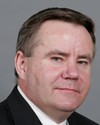We have a process that we call “veteran population”, where we look at where the projected growth is--for instance, among different age groups, or among men or women—so that we can plan services accordingly. For those, we look at areas that are expanding in growth.
For example, Florida has greatly expanded in the number of veterans who are living there part time and full time, so we've had to expand services there. It was one of the first places we used more home health and telemedicine, simply because of the expansions.
We're currently building three new hospitals. They are certainly different models from the hospitals that we have today, recognizing that the average age of our basic medical centre facilities is about 50. So we're certainly planning for rooms to be wired with Internet access, for both the patient and the providers, and for families to be present. We see in this generation that the wife may be there, but also the mother and the father and the siblings may be with that person the entire time too.
We have developed four acute polytrauma centres throughout the country, but we are also divided into 21 networks. They each have a secondary polytrauma centre to be able to deal with these things locally as well.
I think we have the same challenges and could learn from each other. In some things we're trying to play catch-up, such as in technology. Technology is really advancing at a rate that is very difficult to keep up with. So I think we have some similar challenges.




